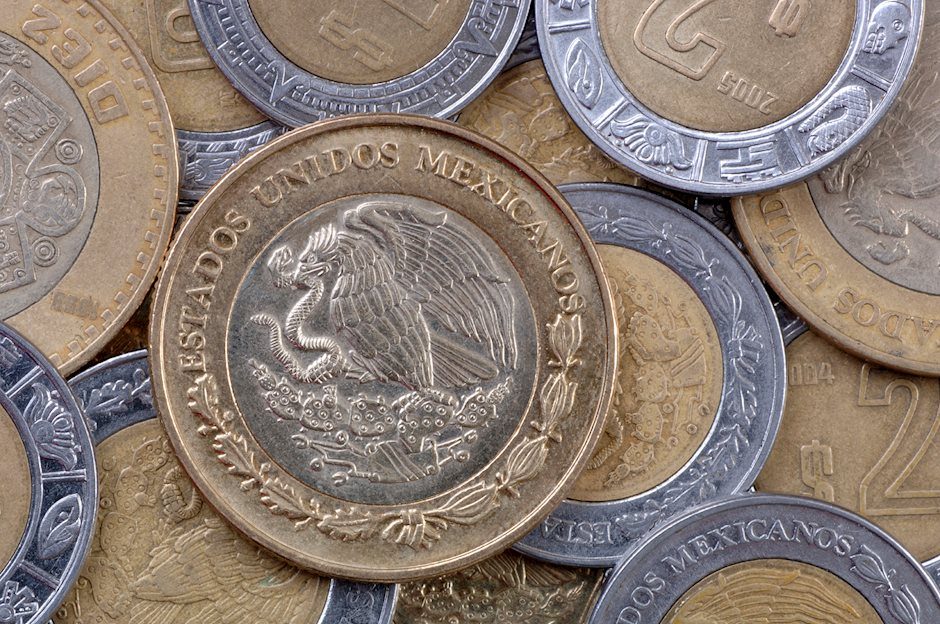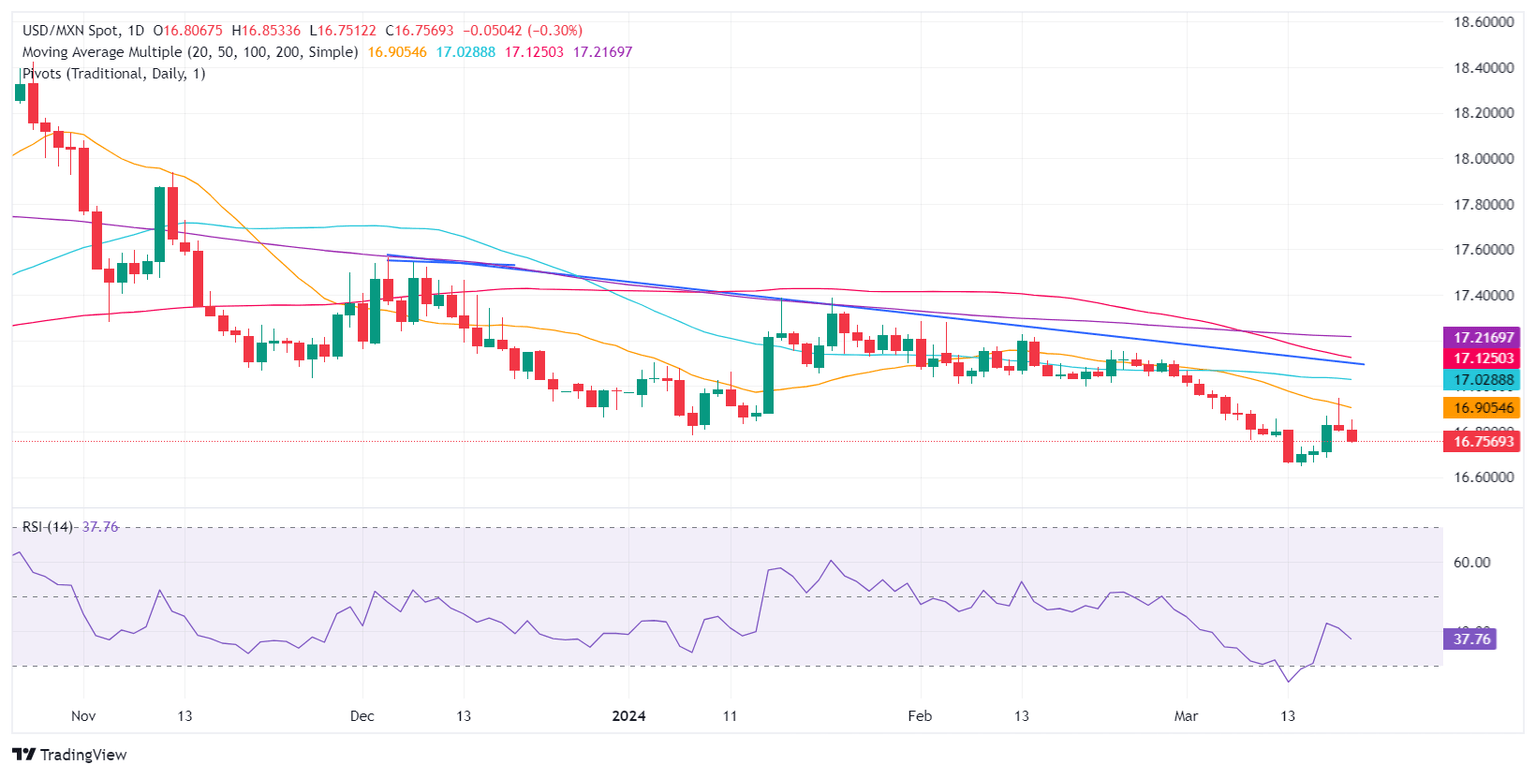Mexican Peso rallies on Fed’s call, traders set sights on Banxico
- Mexican Peso appreciates against the US Dollar, with USD/MXN falling below 16.70 after the Federal Reserve's policy announcement.
- Fed holds rates steady and continues balance sheet reduction.
- Despite recent high inflation data, Fed keeps 2024 rate projections stable but revises 2025 forecast upward.
- Markets focus on the Bank of Mexico's potential start of an easing cycle, with expectations of interest rate cuts on the horizon.

The Mexican Peso (MXN) recovers territory on Wednesday against the US Dollar (USD) after the US Federal Reserve’s (Fed) decided to keep rates unchanged as expected, while maintaining three ratce cuts projected for 2024. During the first half of the week, the Mexican currency has been on the defensive amid speculation that on Thursday, the Bank of Mexico – also known as Banxico – might begin its easing cycle. At the time of writing, the USD/MXN trades at 16.67, down 0.76%.
The US Federal Reserve has kept interest rates steady at 5.25%-5.50% and is continuing its balance sheet reduction at the ongoing pace set since May 2023. Fed officials pointed out the US economy's strength and the labor market's durability, acknowledging progress in managing inflation but emphasizing that more work is needed. They noted an improved balance in the risks to their dual mandate and affirmed their decisions will be guided by incoming data.
Fed Chair Jerome Powell reiterated previous statements from himself and his colleagues, emphasizing the need for more substantial evidence before considering a rate cut. On the topic of higher inflation tolerance, Powell acknowledged the expectation of a "bumpy road" in the disinflation journey towards the Fed's 2% target. He also noted that while inflation figures at the year's start were higher than anticipated, they did not alter the overall narrative of slowing price increases.
Daily digest market movers: Mexican Peso shrugs off Banxico’s imminent cut and rises
- After observing higher-than-expected inflation figures for two consecutive months, the Federal Reserve adjusted its monetary policy outlook for 2025, while the 2024 median forecast remains at 4.6%. The Federal Funds Rate (FFR) forecast for 2025 was increased from 3.6% to 3.9%, among other revised figures.
- Federal Reserve Summary of Economic Projections (SEP) additional figures updated:
- The Gross Domestic Product (GDP) for 2024 was revised to 2.1% up from 1.4% in December.
- The Unemployment Rate was not revised, as is expected to remain at 4.0% down from 4.1%.
- The Personal Consumption Expenditure (PCE) Price Index target wasn’t changed, remaining at 2.4%, while core PCE is estimated to end 2024 at 2.6%, up from 2.4%.
- Estimates that Banxico will lower the interest rate from 11.25% to 11% put “some” pressure on the Mexican currency, which could lift the USD/MXN toward the 17.00 mark.
- Mexico’s economic data released in the week:
- Aggregate Demand rose by 0.3% QoQ in Q4, up from 0%. On an annual basis, it decelerated from 2.7% to 2.6%.
- Private Spending on a quarterly basis slowed from 1.2% to 0.9%. On a yearly basis, it improved from 4.3% to 5.1%.
- On March 21, Banxico is expected to decrease interest rates, even though it could feature a 3-2 vote split. Recent speeches and media appearances show that Banxico’s Governing Council is divided, with Governor Victoria Rodriguez Ceja, Omar Mejia Castelazo and Galia Borja Gomez leaning dovish. On the hawkish front lie Jonathan Heath and Irene Espinosa Cantellano.
- The slowdown in Mexico’s economy is one of the main reasons that Banxico is eyeing the first cut. Mexico’s central bank expects the economy to grow 2.8% YoY in 2024, down from 3%, but maintained at 1.5% for 2025.
- The latest inflation figures in the United States prompted investors to price in a less dovish stance. Money market futures have adjusted their rate cut expectations to be more in line with the Fed's as they foresee the Federal Funds Rate (FFR) at 4.71% toward the end of the year. Analysts estimate the Fed will not change its Federal Funds Rates (FFR) level until June or later.
Technical analysis: Mexican Peso counterattacks as USD/MXN slumps below 16.80
The USD/MXN is neutral to downwardly biased after buyers lifted the exchange rate to a weekly high of 16.94 before retreating beneath 16.80. If the pair extends its losses below 16.78, the January 8 swing low, that could exacerbate a test of last year’s low of 16.62 before diving to 16.32, the October 2015 low.
On the other hand, if buyers lift the pair above the current week’s high of 16.94, that would pave the way for testing 17.00. The next key resistance levels would be the 50-day Simple Moving Average (SMA) at 17.02, the 100-day SMA at 17.16, and the 200-day SMA at 17.21.
USD/MXN Price Action – Daily Chart
Mexican Peso FAQs
The Mexican Peso (MXN) is the most traded currency among its Latin American peers. Its value is broadly determined by the performance of the Mexican economy, the country’s central bank’s policy, the amount of foreign investment in the country and even the levels of remittances sent by Mexicans who live abroad, particularly in the United States. Geopolitical trends can also move MXN: for example, the process of nearshoring – or the decision by some firms to relocate manufacturing capacity and supply chains closer to their home countries – is also seen as a catalyst for the Mexican currency as the country is considered a key manufacturing hub in the American continent. Another catalyst for MXN is Oil prices as Mexico is a key exporter of the commodity.
The main objective of Mexico’s central bank, also known as Banxico, is to maintain inflation at low and stable levels (at or close to its target of 3%, the midpoint in a tolerance band of between 2% and 4%). To this end, the bank sets an appropriate level of interest rates. When inflation is too high, Banxico will attempt to tame it by raising interest rates, making it more expensive for households and businesses to borrow money, thus cooling demand and the overall economy. Higher interest rates are generally positive for the Mexican Peso (MXN) as they lead to higher yields, making the country a more attractive place for investors. On the contrary, lower interest rates tend to weaken MXN.
Macroeconomic data releases are key to assess the state of the economy and can have an impact on the Mexican Peso (MXN) valuation. A strong Mexican economy, based on high economic growth, low unemployment and high confidence is good for MXN. Not only does it attract more foreign investment but it may encourage the Bank of Mexico (Banxico) to increase interest rates, particularly if this strength comes together with elevated inflation. However, if economic data is weak, MXN is likely to depreciate.
As an emerging-market currency, the Mexican Peso (MXN) tends to strive during risk-on periods, or when investors perceive that broader market risks are low and thus are eager to engage with investments that carry a higher risk. Conversely, MXN tends to weaken at times of market turbulence or economic uncertainty as investors tend to sell higher-risk assets and flee to the more-stable safe havens.
Author

Christian Borjon Valencia
FXStreet
Christian Borjon began his career as a retail trader in 2010, mainly focused on technical analysis and strategies around it. He started as a swing trader, as he used to work in another industry unrelated to the financial markets.


















